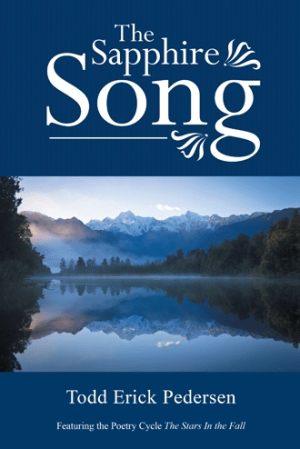The Sapphire Song
This timeless mystical fable introduces spiritual themes of true love and the individuality of the quest for truth.
A stoneworker and a storyteller fall in love and undertake a quest for wisdom in this mystical parable. Todd Erick Pedersen’s The Sapphire Song brings two characters of divergent backgrounds together in an allegorical journey to discover the eternal virtues of truth and love. Pedersen introduces timeless spiritual themes through his mystical prose-poetry.
Metaxaeus is a young stone carver whose greatest work, a sapphire-alabaster amulet of a phoenix and a lotus, was carved from stones donated by Maya, an old woman in the forest. Though illiterate, he practices daily meditation, his “orison.” Little does he know that Akasha, a storyteller, also meditates along the same riverbank. The two are destined to enter a supernatural romance, dreaming of each other long before they ever meet. When fate brings them together, they set off for a mountain cave on a quest for unchanging truth.
Akasha and Metaxaeus are two of only three named characters. As is common with allegories, they are not described in much depth because they are symbols rather than three-dimensional characters. They appear to represent two types of creativity: Metaxaeus’s is primal and preliterate; Akasha’s is written and overtly moralistic. Perhaps they, like the phoenix and the lotus, stand for two traditions celebrating rebirth: Greek mythology and Buddhist philosophy. Besides this pair, the central characters are Maya and the white-bearded shaman in the cave. These two fulfill fantasy tropes: the crone in the woods and the aged wizard.
This is a timeless quest narrative, redolent of The Hobbit. However, Pedersen retreats before giving details of any epiphanies in the cave. Metaxaeus and Akasha spend many “seasons lodged in the mountains at the high dwelling of this old sage, as they each learned … the several secrets of his ancient spiritual lineage.” By coyly refusing to reveal these secrets, Pedersen emphasizes the individuality of every quest for truth. Yet, by splitting his lovers and presenting alternative scenarios in which they meet later in life, the book undermines the power of true love, which seems so foundational to the plot.
The author uses archaic vocabulary (“aetheric” and “aeonian”) to enhance a timeless mood. A particular fondness for adverbs extends to invented ones, such as “breathingly” and “singingly.” Some passages have language that is almost breathtakingly lyrical: “Electric blue dragonflies alighted, like small omens” and “the cerulean psalm of the silent silver twilight.” Others, though, seem overwrought or clichéd, such as “all the livelong day betwixt and between the rising and setting of the wonderful sun” and “the infinite vast of possibility which oft lies on just the other side of a bad outlook.” Moreover, an appendix of prose-poems feels unnecessary; these might have been shortened and incorporated into the main text.
Pedersen’s work is considerably more esoteric than your average teen-geared supernatural romance. The Sapphire Song is a subtle religious allegory in a gently fantastical wrapping, echoing works from Tolkien to Hermann Hesse’s Siddhartha.
Reviewed by
Rebecca Foster
Disclosure: This article is not an endorsement, but a review. The publisher of this book provided free copies of the book and paid a small fee to have their book reviewed by a professional reviewer. Foreword Reviews and Clarion Reviews make no guarantee that the publisher will receive a positive review. Foreword Magazine, Inc. is disclosing this in accordance with the Federal Trade Commission’s 16 CFR, Part 255.

